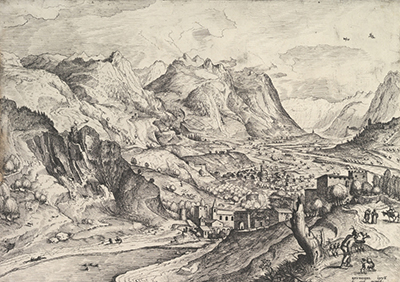The Crafty Bird-Catcher was a delightful etching from Pieter Bruegel in the 16th century which was then printed up by colleagues and distributed to interested patrons. It was a part of a larger series titled The Large Landscapes.
Rolling hills and mountains appear once more in this example. We find an open area of land to our right, where a few figures can be seen. A bridge or road appears to stretch out into the distance in order to provide perspective and a row of buildings can be seen at the bottom of the hills. He would go into huge detail within his landscape scenes, never neglecting any part of his canvas or etching, so that huge amounts of visual information would fill every corner. This worked best within his paintings, where colour and a larger number of figures were used, whilst in the example of The Crafty Bird-Catcher it is more about impressing us with his supreme technical skills as an etcher which could then be used to earn additional income from the resultant prints. The techniques of etching were commonly found within 16th North European art and would be handed down a generation at a time before interest in the medium later started to drift away.
Bruegel would have spent a considerable amount of time in designing each of these artworks before then handing them over for the engraving and print stages of the publishing process. All of those involved believed that this series could help them to collectively achieve fame across other parts of Europe, with the prints far easier to sell on and distribute across borders rather than other mediums such as original oil paintings that would be large and only for those with large budgets. The same approach has benefited others within Northern Europe, such as Rembrandt who made use of the major port cities in order to commercialise his work as much as possible, which then provided finance for his growing collection of original artworks from other artists. Unfortunately for him, it was not enough to avoid bankruptcy, as his extravagant lifestyle would eventually catch up with this talented portrait painter.
Head to the Metropolitan Museum of Art if you want to see these items in person, as they host most of the remaining engravings and prints. They may not always be on display, though, because of the extraordinary collection of this mammoth art venue that covers art and antiquities from many different civilisations within their multitude of buildings. Much will be loaned out to provincial galleries so that as much can be on display as possible, though some of the best items to be found here, and items that will normally be found here, include Christ Asleep during the Tempest by Eugene Delacroix, Portrait of Madame X by John Singer Sargent and The Four Trees, (Four Poplars on the Banks of the Epte River near Giverny) by Claude Monet.




